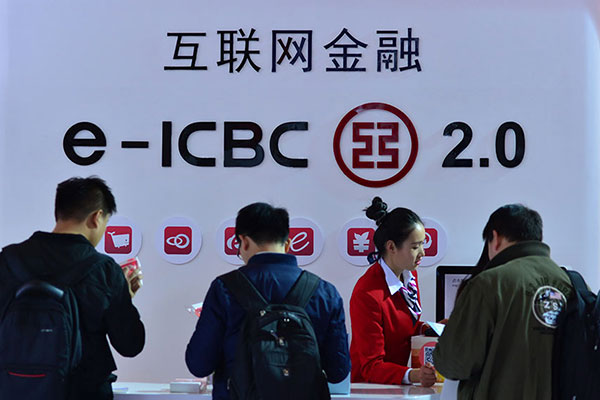
Visitors check out new financial products at ICBC’s booth at the Beijing International Wealth Management Expo in 2015. [Photo/China Daily]
Commercial banks are accelerating efforts to adjust their wealth management products or WMP business according to new regulatory requirements, as China is stepping up control over financial risks.
It is expected that China will soon formally launch guidelines to tighten rules on the asset management business of various financial institutions.
Top leaders of the country have approved new regulations for the asset management sector to tackle off-balance-sheet lending and eventually address China’s debt problems, bankers said.
Gu Shu, president of Industrial and Commercial Bank of China Ltd, the country’s largest commercial lender by assets, has a positive attitude toward the regulatory tightening.
“To develop the asset management business well … there should be regulations and standardized development,” Gu said at a recent news conference.
As at the end of 2017, the balance of ICBC’s wealth management products stood at 3 trillion yuan ($477 billion), up 11.4 percent from the previous year. The bank ranked first among its peers in terms of the stock and the increase of WMPs, he said.
“We are designing net-worth wealth management products, which are in line with regulatory requirements. We are also doing research on transforming non-standard asset investment into standard asset investment. In terms of risk control, we are simplifying our product system and reducing embedment to increase penetration of WMPs according to new rules,” he said.
So, Gu is confident that ICBC’s asset management business will develop in a sustainable and more standardized way after the new regulations take effect.
Zhao Huan, president of Agricultural Bank of China Ltd, said regulatory tightening will motivate commercial banks to operate legally and in compliance with rules and thus contribute to sustainable and healthy development of banks.
“We will follow new regulations on interbank and asset management businesses so that the interbank business will head in the direction of bridging the short-term funding gap, and the asset management business will meet the requirements of serving the real economy, shifting toward net-worth wealth management products that are similar to open-end funds, and lowering the risk of maturity mismatch,” Zhao said.
Under the overall policy, these two types of business will remain relatively stable, he said.
While streamlining their asset management business, many banks made moves to meet growing client demands for globalized asset management portfolios.
Last year, ICBC set up a company in Hong Kong for international asset management. Just a year later, the latter’s assets under management have reached over HK$100 billion ($12.74 billion).
As at the end of 2016, the volume of the asset management business in China reached 116.18 trillion yuan, according to a report published by the China Banking Association.
Some 497 commercial banks issued 100,107 accumulative WMPs. The outstanding balance of WMPs reached 29.05 trillion yuan, or 25 percent of the entire asset management business nationwide, at the end of 2016.
Since last year, the country’s top banking regulator has been issuing a number of directives to reduce financial leverage, address noncompliant practices and improve risk management.
As at the end of January, the balance of interbank WMPs dropped by 3.6 trillion yuan year-on-year. The growth of the wealth management business fell to 1 percent, down by 26.6 percentage points from the previous year.
The war on financial risks will continue this year, with renewed efforts to crack down on shadow banking activities and further rectification of financial irregularities, said Guo Shuqing, head of the regulator for the banking and insurance industries.
